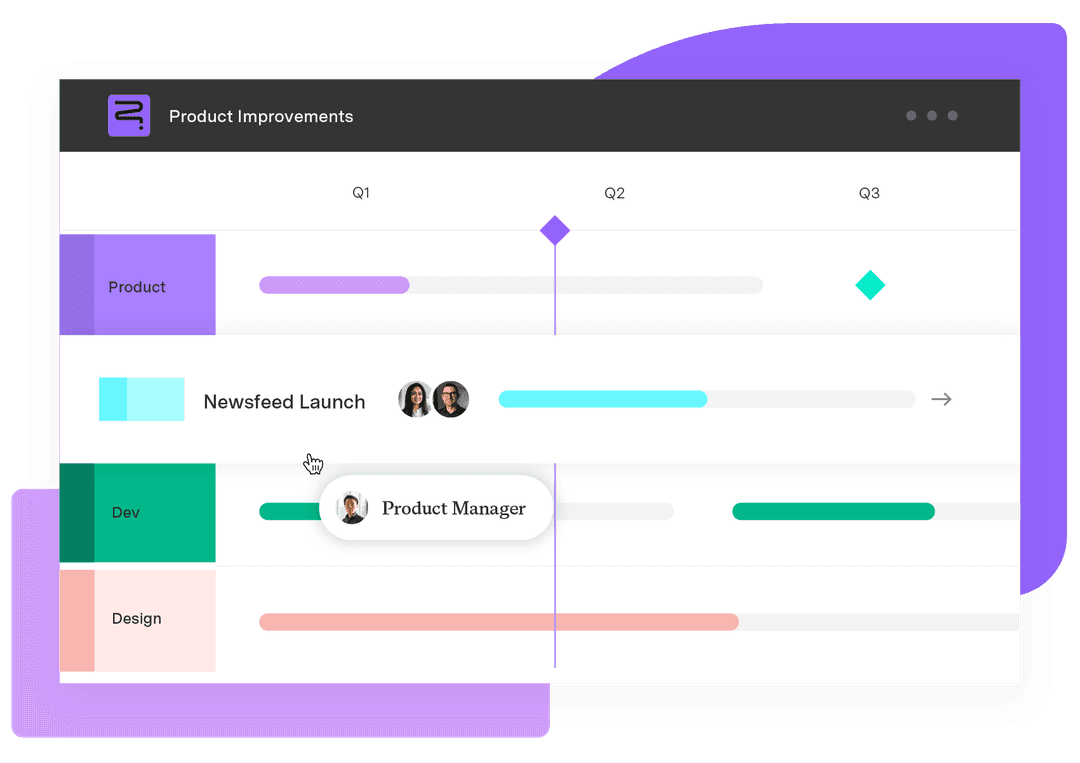Strategic roadmap templates for effective goal alignment
Tempo Team
A business’s vision statement is its North Star, directing everything from product and value propositions to supplier and customer relationships.
But over time, that guiding light can become dim and distant. When alignment begins to fade, the team needs a compass to get back on track. That’s exactly what a strategic roadmap offers.
What is a strategic roadmap?
A strategic or strategy roadmap represents an organization’s strategic plan. The roadmap establishes a business’s current state and outlines the steps necessary to achieve upcoming strategic goals, including key milestones and deadlines.
A visual strategic roadmap is a powerful communication tool that establishes a shared understanding of the company’s strategic vision and how to make that vision a reality. It illustrates goals, initiatives, and timelines alongside potential risks and obstacles, providing a high-level overview of the organization’s direction.
The roadmap also acts as a benchmark, informing decision-making to ensure every management decision supports the company’s long-term objectives.
A strategic roadmap can’t predict whether a company will achieve its goals, but it can help teams determine what course of action will realize them. When employees struggle in the face of market uncertainty, economic challenge, or corporate stagnation, a clear roadmap provides the inspiration they need to keep moving forward.
Understanding the difference: Strategy vs. roadmap
Organizations often confuse roadmaps with strategies. The concepts aren’t identical, but they are complementary.
A strategy outlines a company’s approach to achieving long-term goals and a desirable future state. These aspirations are typically centered on the company’s vision statement. A roadmap outlines the tactical steps the organization will take to accomplish those goals.
In other words, a roadmap can’t exist without a strategy, and a strategy won’t succeed without a roadmap to guide it.
Key steps to develop a strategic roadmap
Creating a roadmap for a strategic plan requires input from employees of all levels and across departments. Here are the steps stakeholders must take to turn ideas into actions:
1. Review the company’s vision statement
The company’s vision statement guides the entire process, so roadmap development begins with reassessing that vision. Stakeholders should appraise the statement to ensure it remains current, impactful, and reflective of the organization’s values.
2. Define strategic goals and objectives
Using the strategic vision as a guide, leaders outline the long-term goals and objectives the organization wishes to achieve.
3. Establish initiatives
Next in the roadmapping process, stakeholders identify strategic projects and initiatives that contribute to attaining long-term goals.
4. Determine action plans
Stakeholders then roadmap a strategy by dividing each initiative into actionable steps. These include clear directives to guide the teams and individuals responsible for its execution.
Here, you might have different plans for each team. The product team might need to develop a new feature while the marketing team focuses on boosting sales for the previous rollout. Detail all the necessary steps to meet the goals you set.
5. Identify risks and dependencies
Stakeholders and decision-makers then review the roadmap to identify projects and initiatives with shared dependencies that could impact the delivery timeline.
During this process, they also identify potential roadblocks and create risk mitigation plans to manage their impact. Spending time problem-solving now will prevent a total project derailment later.
6. Define timelines
Once plans and contingencies are established, stakeholders can establish a sequence of completion by prioritizing each objective within the timeline. Some objectives might be dependent on others, as previously identified, meaning Project C can only begin after Project B is complete. Others might be date-based, requiring completion by specific deadlines.
Leaders should also include key milestones to help employees measure progress and encourage focus as they work toward the finish line. They may set dates for projects to be 50% finished or establish regular deliverable quotas.
7. Communicate
Once the strategic roadmap is complete, the development team can communicate the outcome to the organization. Stakeholders should be prepared to answer questions and solicit buy-in.
8. Reassess regularly
Strategic roadmapping is an ongoing process. Organizations can’t roadmap a business plan and forget about it after launch. Management should revise the roadmap annually and conduct quarterly check-ins to ensure they continue implementing strategic initiatives that advance the corporate vision.
The company should also revisit the roadmapping process whenever a significant shift in market forces or a new technological advance affects the business.
Advantages of implementing a strategic roadmap
There are numerous benefits to building a strategic roadmap, including the following:
1. Alignment
A strategic roadmap aligns company stakeholders with the big picture. It ensures everyone, from the C-suite to the mailroom, is on the same page regarding the organization’s mission, vision, and long-term goals. It also secures buy-in for the initiatives necessary to achieve those goals.
When you have a visual roadmap to share with team members, everyone can see exactly how their tasks contribute to the organization’s success.
2. Prioritization
When a business prioritizes project execution with a strategic roadmap, teams can identify and align with initiatives that further the vision statement and achieve organizational success.
3. Communication
A strategic roadmap is a powerful communication tool. Its visual nature simplifies complex strategies and organizes them into an easily digestible format.
4. Flexibility
The strategic roadmap’s framework readily adapts to evolving business environments and dynamic strategic objectives. The process can be adapted for smaller initiatives, including project or product roadmaps that link to the overarching strategic vision.
Best practices for building a strategy roadmap
An effective strategy roadmap doesn’t only establish the sequence of events necessary to achieve an objective. It also illustrates how to execute the plan. Apply these practices to ensure the roadmap delivers:
1. Simplicity
Every team member should understand the roadmap, no matter their professional role. Keep the outline straightforward by avoiding complexities and niche technical terms.
2. Involvement
The strategic roadmapping process should involve as many voices as possible to secure widespread acceptance and support. Input from diverse stakeholders will improve the outcome and foster collective ownership among employees.
3. Flexibility
Market conditions will always change; the company’s vision and strategy should adjust alongside them. Design the roadmap with fluidity in mind to adapt to the changes while keeping big-picture objectives in sight.
4. Communication
Offer employees regular roadmap progress reports to maintain alignment and engagement. Transparency fosters commitment and involvement from your staff.
Get the templates and tools to do roadmapping right
Your strategic roadmap needs clarity, color, and visual appeal to ensure a positive impression. Tempo’s Strategic Roadmaps software is the ideal roadmapping tool for the job. Strategic Roadmaps helps you quickly create and update intuitive, boardroom-ready roadmaps – and seamlessly connect strategy to work being done.
With our cutting-edge solution, creating strategic, project, and product roadmaps is a breeze. If you’re new to the process, Tempo provides simple strategic roadmap examples to guide your initial roadmapping efforts and strategic roadmap templates to speed up the process.
Whether you’re developing a long-term strategic vision or a new product idea, a roadmap that illustrates corporate objectives will help your peers understand and achieve those goals.











































